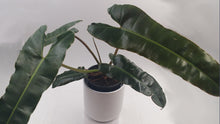Philodendron "Black Billietaie"
Description: The Philodendron "Black Billietaie" is a stunning tropical houseplant known for its unique, deep green to almost black, glossy foliage. This particular cultivar is characterized by its attractive, dark-colored leaves, making it a popular choice among indoor plant enthusiasts. Its striking appearance can add a touch of elegance to any living space.
Growing Instructions:
-
Light: Provide bright, indirect sunlight for your Philodendron "Black Billietaie." While it can tolerate lower light conditions, it will thrive best with consistent, filtered sunlight. Avoid exposing it to direct sunlight, as this can scorch its leaves.
-
Temperature: Maintain a warm and consistent temperature between 65°F to 80°F (18°C to 27°C). Avoid placing the plant in drafts or near heaters or air conditioning vents.
-
Watering: Allow the top inch of the soil to dry out before watering. Water thoroughly, but make sure the plant is not sitting in standing water. Overwatering can lead to root rot, so it's better to err on the side of underwatering.
-
Humidity: Philodendrons appreciate higher humidity levels. You can increase humidity by misting the plant regularly, placing it on a humidity tray, or using a room humidifier.
-
Soil: Use a well-draining, high-quality potting mix with good aeration. A mix formulated for aroids or tropical plants works well.
-
Fertilization: Feed your Philodendron "Black Billietaie" every 4-6 weeks during the growing season (spring and summer) with a balanced liquid fertilizer diluted to half strength. Reduce or halt fertilization during the winter months when growth slows.
-
Pruning: Trim leggy or yellowing leaves to maintain the plant's shape and overall health. New growth typically emerges from the center of the plant.
-
Repotting: Repot your Philodendron when it becomes root-bound, usually every 2-3 years. Spring is the best time for repotting.
-
Pests and Diseases: Keep an eye out for common houseplant pests like spider mites and mealybugs. Treat any infestations promptly. Philodendrons are generally hardy and resistant to most diseases.
-
Support: Consider providing a moss pole or trellis for your Philodendron to climb on. This can encourage it to grow upright and produce larger, more impressive leaves.




